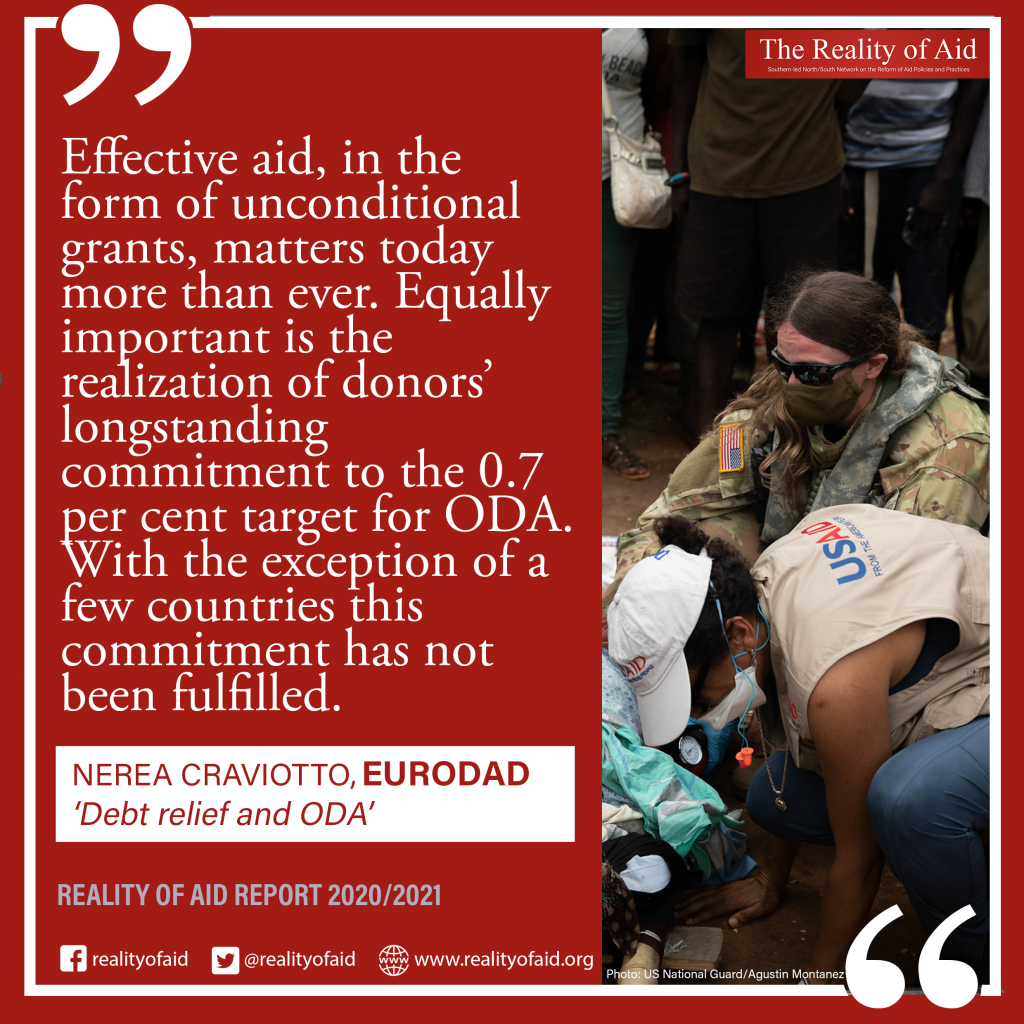Eurodad‘s Nerea Craviotto discusses the relation between ODA and debt relief in light of new rules for reporting debt relief confirmed by the OECD DAC in ODA July 2020, providing a concise critique of the rules and their implication, and points to the need to closely monitor and review the rules moving forward and ensure that policies promote responsible and sustainable financing.

DEBT RELIEF AND ODA
Nerea Craviotto, Eurodad
This is an excerpt from a chapter in the RoA Report 2020/2021.
The world is in an unprecedented, multi-faceted crisis with the COVID-19 pandemic hitting developingcountries particularly hard.
Oxfam has estimated that half a billion people could be pushed into poverty, leading to increased social, economic and gender inequalities. Economically speaking, developing countries have taken an enormous hit. This is occurring in a context where debt obligations were already at high levels, a situation which has a significant negative effect on public service expenditures. The United Nations Development Programme (UNDP) expects that these factors will result in developing countries losing more than US$220 billion of their expected income. As the poorest and most vulnerable countries lack the monetary, fiscal and administrative capacity to respond adequately, the consequences of a combined health emergency and global recession are likely to be catastrophic.
Since the start of the pandemic, the G20 has repurposed the established Paris Club debt treatment mechanisms to tackle developing countries’ unsustainable debts. In April 2020, the G20 adopted the Debt Service Suspension Initiative (DSSI) whereby bilateral official creditors will, for a limited period, suspend debt service payments from the poorest countries that request this suspension. The International Monetary Fund (IMF) also offered a token amount of debt relief. However welcome, these are limited and short-term solutions.
It is unlikely that DSSI-eligible countries will be able to redeploy the temporarily saved resources to tackle COVID-19 because (1) These countries still have to meet their public external debt service obligations; and (2) The lack of commitment by the international community to provide long-term financing reduces the likelihood that countries will be able to redeploy all available resources towards emergency response efforts.
Official Development Assistance (ODA) has the potential to play a crucial role in tackling the immediate impacts of the coronavirus crisis and in supporting a recovery centred on human rights, gender equality and a just transition. However, it seems certain that aid spending will remain at current levels, if not less, in the coming years.
Effective aid, in the form of unconditional grants, matters today more than ever. Equally important is the realization of donors’ longstanding commitment to the 0.7 percent target for ODA. With the exception of a few countries this commitment has not been fulfilled. In July 2020, the OECD-DAC confirmed new rules for reporting debt relief as ODA. This agreement was reached in the midst of an escalating debt crisis, compounded by the pandemic, and is likely to only exacerbate this crisis.
At the 2014 High Level DAC Meeting, members agreed to change the way loans would be reported as ODA in the future, from a system based on cash flows to a grant equivalent system. The grant-equivalent system is sensitive to the loan’s risk profile so the higher the risk donors take with their loan programming, the more ODA value they can report. With this methodology repayments are not deducted. In 2020 further changes to the reporting rules allow DAC members to report any debt rescheduling or cancellation as ODA, even though these loans had already been reported as ODA when they were issued. In practice this means that they can report increases in ODA figures without actually raising their ODA budgets in real terms.
Some of the issues and effects that follow from these changes relating to debt relief include:
1. This new method generates inflated ODA figures and allows double counting.
2. Delaying debt relief increases the amount of ODA that can be reported.
3. An equal amount of ODA can be recorded for rescheduling a loan as for forgiving this loan.
4. The methodology encourages the provision of loans to lower-income countries.
5. An agreement taken with little transparency or inclusivity.
The new debt relief rules have the potential to create a situation where loans, rather than grants, are favoured by ODA donors. The benefits for a donor, particularly in terms of ODA reporting, are very attractive. Butthe decision to provide debt relief shouldbe informed by the economic necessity of a recipient country rather than ODA accounting considerations.
The top priority for DAC members should be to ensure that the systems put in place promote responsible and sustainable financing. In this sense and following the whole ODAmodernisation process and related reporting, members of the DAC should seriously consider an external review of the changes made over the last few years to continue ensuring the quality of ODA statistics.
